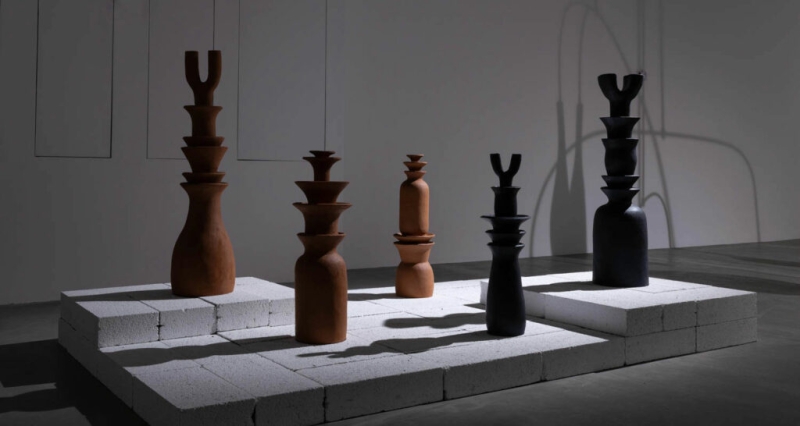Contents
- 1 How Dina Nur Satti Decolonizes Art Through Her Ceramics Practice
- 1.1 Interior Design: How did your journey as a ceramic artist begin?
- 1.2 ID: Can you describe your background?
- 1.3 ID: What was it like for you switching career paths? Did you face any sort of pressure from people for leaving your former job?
- 1.4 ID: You’re a ceramic artist who is inspired by dance and music which is incredible. How did that fit into your inspiration board?
- 1.5 ID: How would you describe your creative process?
- 1.6 ID: When you became a ceramic artist, were you interested in carving a visual language of what your work should look like?
- 1.7 ID: Your approach to shape is very different; it’s like you’re trying to recreate an object not typically made with clay. Where do you find inspirations for these shapes?
- 1.8 ID: You currently have a group exhibition at the Efiɛ Gallery Dubai, tell us about the works?
- 1.9 ID: This is your first exhibition in the Middle East; what does it feel like?
- 1.10 ID: Do you have a forthcoming solo exhibition this year?
Dina Nur Satti’s the Lotus Series as part of the “Dance Will Be You” group exhibition at the Efiɛ Gallery in 2025. Photography courtesy of Efiɛ Gallery.
The first thing to note about Dina Nur Satti is that she’s very intentional about decolonizing art. The art practice of the Sudanese-Somali ceramic artist, who is based in Brooklyn, is deeply rooted in re-learning her own histories and reclaiming her personal and cultural identity. While she heavily relies on researching and deconstructing made up notions about traditions, cultures, and history, art to her is beyond the physical; it’s become a deep form of healing and a connection with both her personal spirit and her ancestors, which is why her source of inspiration takes different forms and means.
Satti studied international and intercultural studies with a focus on the cultures of Africa and the Middle East, known as the Southwest Asia and North Africa (SWANA) region, at Fordham University where she eventually took a career in development, working with a foundation in New York. It was a job that felt out of place for her, but she soon felt a calling for ceramics, viewing this as a possible affirmation of her spiritual path. “It was like a vision for me,” she recalls. “I saw two paths in my life: One was a path where I would keep with the conventional world and my choices that everyone expects me to do, and I would make money and I would be okay, but I wouldn’t really be happy. And the other was my story now.”
Her peculiar ceramic forms come from a subtle layering, a mimicry of the lotus flower’s vertical movement up through the water. She currently has a group exhibition “Dance Will Be You,” which will be open until March 26, 2025 at the Efiɛ Gallery, Dubai. For Satti, she says it feels incredible to bring her work to a new audience in her first exhibition outside the United States. Interior Design sat down with the artist to discuss her career, decolonizing art, and her latest exhibition in Dubai.
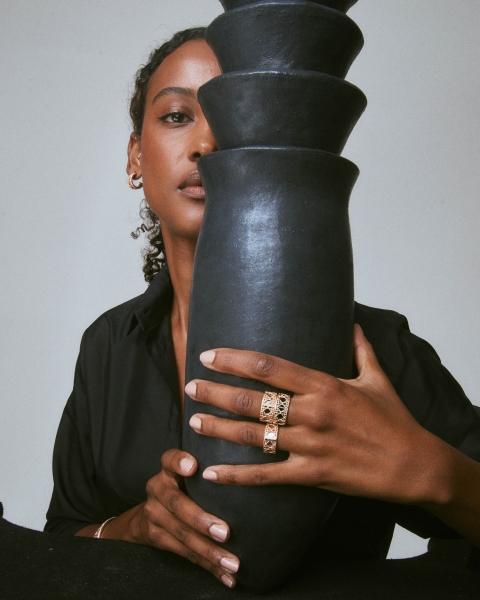
Dina Nur Satti. Photography courtesy of Brett Warren.
How Dina Nur Satti Decolonizes Art Through Her Ceramics Practice
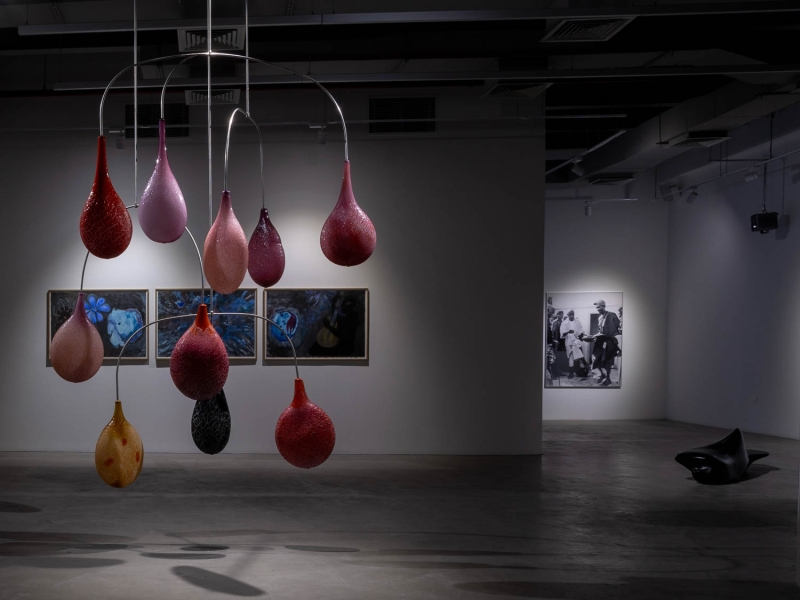
“Dance Will Be You” is a dialogue with artists practicing art as an act of transcendence, devotion, and freedom, collectively offering a presentation of nuanced explorations into the symbolic and performative dimensions of contemporary African art. Photography courtesy of Efiɛ Gallery.
Interior Design: How did your journey as a ceramic artist begin?
Dina Nur Satti: I never grew up with the idea that art could be a full time job. Everyone in my family was either a doctor, in academia, or an engineer. So, my first pursuit was a career in development. I worked for a foundation in New York for seven years. My father is from Sudan and my mother is from Somalia. I grew up very close to my father’s family in Sudan and we used to visit them almost every summer growing up. We’re from the border between Sudan and Egypt, an area called Nubia. And that tradition—this is pre-Islamic—is rooted in art and ritual. As I got older, I started to realize that I had this creative expression within me, and it was rooted in where I come from. In my early twenties, I started to meet artists in New York City and people who were connected to art from their lineage. I found that they had a sense of purpose in their life and a sense of drive that I hadn’t experienced before.
I started exploring different mediums of art on the weekends or whenever I had some time off. I had some foundational experience with art, since I always had an interest in art, and took photography and drawing classes in university. I also took classes in Arabic calligraphy, European calligraphy, watercolors, dance, and eventually I took a class in ceramics. I loved ceramics because it was something so ancient and universal. For me, it awakened something very old. When I touch clay, I recognize something in the way it communicates with me that is very deep. It was almost like it took me away from my previous path and then told me, this is going to be your new life and path. I knew that if I didn’t make a change in my career at that point, I wouldn’t be able to do it later in life. So I took that leap of faith.
ID: Can you describe your background?
DNS: I grew up with a father that has a very Sufi understanding of the world, which is mixed with our Nubian, Indigenous way of understanding the world. Growing up, he used to tell me that the only thing that you have to do in life is to be on a path of curiosity and seeking.
My grandfather is from the Sudanese side of Nubia and my grandmother came from the Egyptian side of Nubia. Her family is originally from Aswan, from southern Egypt. My mother is Somali, and we’re from a tribe called the Darood. This is also an old indigenous Somali lineage, and my mother and family told me stories about how Somalia used to be, which is very different from Somalia now. There is a deep mysticism in our region of the world; many of our people are seers and have visions in dreams, which is why we align so much with Sufism, the mystical branch of Islam. It’s so common, even if it sometimes clashes with the more conservative Islam that has recently influenced the region.
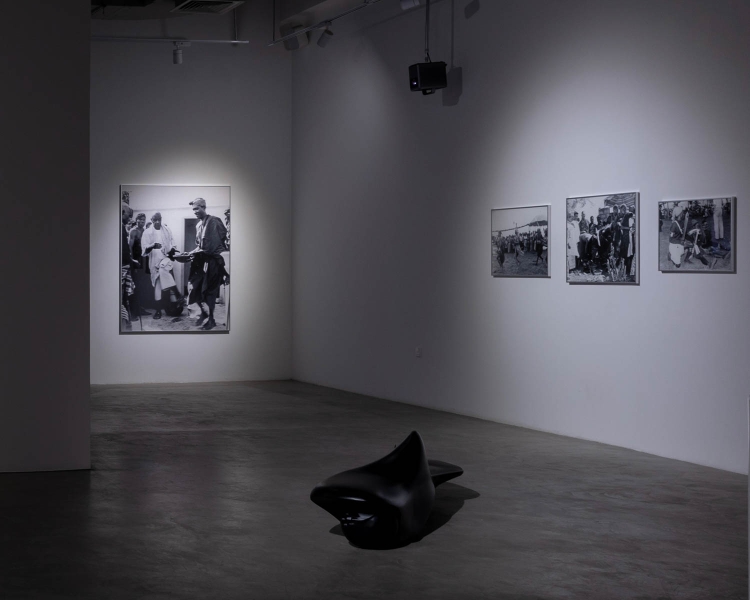
Installation view from “Dance Will Be You” group exhibition at the Efiɛ Gallery, 2025. Photography courtesy of Efiɛ Gallery.
ID: What was it like for you switching career paths? Did you face any sort of pressure from people for leaving your former job?
DNS: Being an artist is almost like a spiritual path because you need so much strength within you to choose that path, because society is not really built to support artists. So, I had pressure within myself and I also had pressure from people around me asking what I was doing. You’re leaving a career. You got a degree. You’re working for seven years, and now you’re going to become a ceramic artist? It was that internal drive where I knew that this was the path for me. It’s difficult to explain it. But you know, at the end of the day, you’re going to be more aligned and more happy with your life and with yourself. And so, I took that leap of faith. For me, I knew that that unknown path was going to be the path where I was going to learn the most.
ID: You’re a ceramic artist who is inspired by dance and music which is incredible. How did that fit into your inspiration board?
DNS: I think for me, I don’t use dance and music in my actual creative process. I used to take African dance classes and it taught me what it means to take an emotion and move it to the physical expression. So, when I started to make ceramics, I already had the blueprint for my feelings and how to turn them into the physical; so instead of dance, now it became pottery.
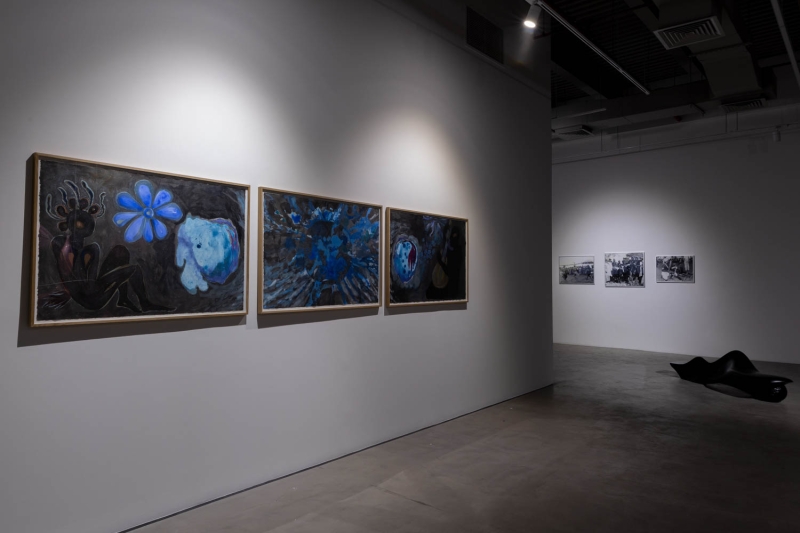
Borrowing its title from Sonia Sanchez’s We a BaddDDD People (1970), the exhibition echoes her reflections on transformative expression and unity. Photography courtesy of Efiɛ Gallery.
ID: How would you describe your creative process?
DNS: My whole life is a creative process on some level because my creative practice is mixed with my own personal evolution. Every day, whether or not I’m in the studio, I’m continuously moving and figuring out how to open up myself and my creative capacity to physically bring what I want to create into the world. I’m reading books and doing research almost every day because much of my practice is also about this idea of decolonizing art within my own culture and within my own self. I’m doing a lot of research to understand and to relearn not only my culture, but also what happened in history to subjugate Indigenous people and Indigenous art. So for me, my practice is based on research to understand better what is the historical significance of what we’ve gone through as colonized people. Another reason is to also understand that culture is always evolving, but we can still be rooted in where we come from.
ID: When you became a ceramic artist, were you interested in carving a visual language of what your work should look like?
DNS: When I’m creating these pieces, I don’t have a plan. A lot of the time, I’m feeling where the clay wants to go, and it’s a discovery as I’m building it. It’s almost like it has a spirit; it wants to be something. So you’re in this collaboration with earth. I find that a lot of the shapes that come through me are very similar to the pottery of ancient Nubia, particularly that of Kerma, which is in the region where my father’s family is from. It was one of the great ancient African pottery civilizations.
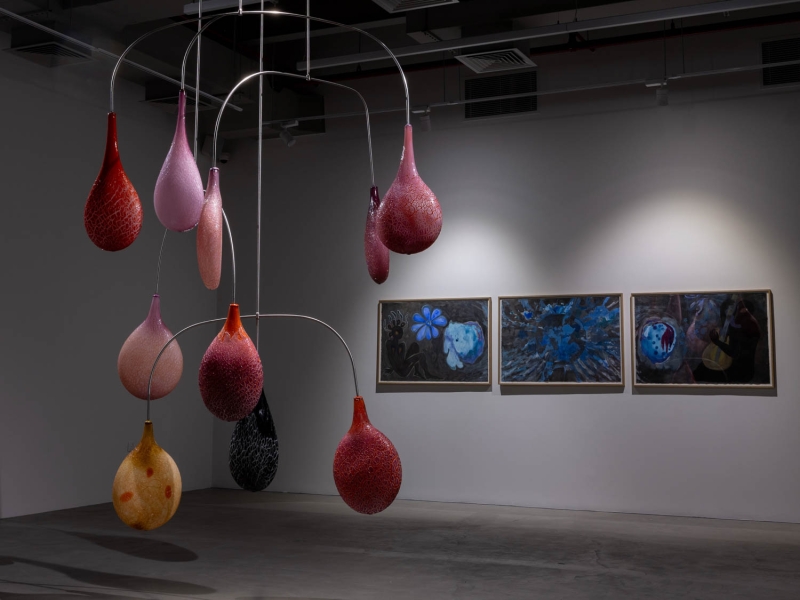
Part of “Dance Will Be You” group exhibition at the Efiɛ Gallery. Photography courtesy of Efiɛ Gallery.
ID: Your approach to shape is very different; it’s like you’re trying to recreate an object not typically made with clay. Where do you find inspirations for these shapes?
DNS: I have different books on herbalism from East Africa. I started to see that I was drawn to certain plants, like the baobab, or I would be drawn to the acacia, or the lotus flower. I recently found out that the lotus flower was one of the plants that survived the Ice Age and it spread into almost every ecosystem throughout the world. And so, it has represented immortality in a lot of mystical cultures. We have the lotus all over the Nile and in some of the old temples I used to visit with my father. There’s this Nubian god at one of the temples at Musawsarat-Al-Sufra called Apademak that has the head of a lion, the torso of a man, and the body of a snake, and he’s emerging out of a lotus. I became curious about the lotus because we often associate it with Buddhism or Hinduism.
So I started to study the similarities between these two cultures and the symbolism that the lotus flower represents; it first comes from the mud, then it has to move through the murky water, and eventually it blossoms on the surface and becomes this beautiful flower. In those cultures, it became a symbol for the spiritual path—you have to go through the darkness, and eventually, you break through the darknes, and awaken into your own light. Then, I realized when creating those layers in my work, it represented the movement of the lotus flower up through the water.
ID: You currently have a group exhibition at the Efiɛ Gallery Dubai, tell us about the works?
DNS: The works at this exhibition are a continuation of the Lotus series. But some of the forms are new, which I’ve named the Tower Lotus. They look like cow horns at the top or they could be crescent moons as well. There is a great connection in many ancient Indigenous traditions between the cow and the crescent moon and their association with the feminine principle. These are symbolic forms I have revisited many times throughout my practice and I associate them with the Acacia tree as well. They remind me of the branches of the Acacia, which is a prolific tree in many African landscapes and it’s a medicinal plant that is also used in Sudanese incense making. For me, there is a triple symbolism there.
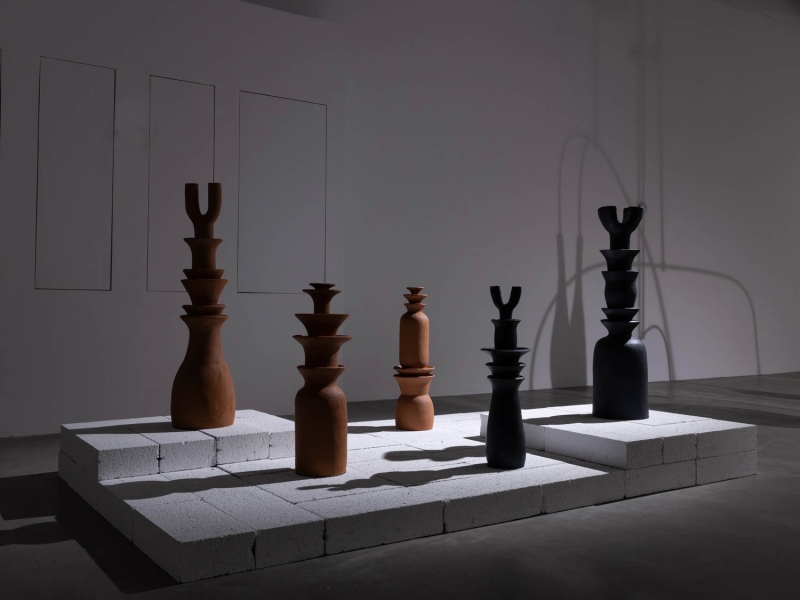
Dina Nur Satti’s the Lotus Series as part of the “Dance Will Be You” group exhibition at the Efiɛ Gallery in 2025. Photography courtesy of Efiɛ Gallery.
ID: This is your first exhibition in the Middle East; what does it feel like?
DNS: This is my first show outside of the U.S. and it’s a really powerful moment because living in the United States can make you feel so disconnected from your region. There are a lot of Sudanese people here, so my work can be experienced by the community on a scale that might not be possible in New York City. Also, the idea of the Middle East, or SWANA region, is so complex and our belonging to it as Sudanese people is not very clear. Sudan is located at a crossroads, which is what makes us so culturally rich and diverse. Sometimes, we get grouped as Middle Eastern because we speak Arabic, but everyone in Sudan relates to their identity differently and we all have different heritages we root ourselves in. For me personally, I don’t feel Middle Eastern or Arab, I feel African first and my family has elements of Arab culture that has mixed with our own Indigenous culture but that doesn’t speak for Sudan as a whole; that’s just my personal experience.
ID: Do you have a forthcoming solo exhibition this year?
DNS: Yes, I do actually. I have some pieces showing at the 1-54 art fair in Marrakech with Ross-Sutton Gallery, just a few days after the opening in Dubai. I’m also working with Montague Contemporary, which is an African art gallery here in New York to plan my first solo show, most likely in May of 2025.
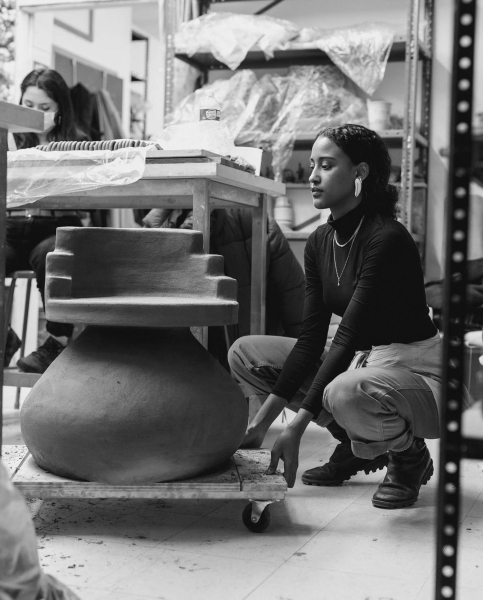
Dina Nur Satti. Saint Heron Residency 2022. Photography courtesy of Myesha Evon Gardner.

